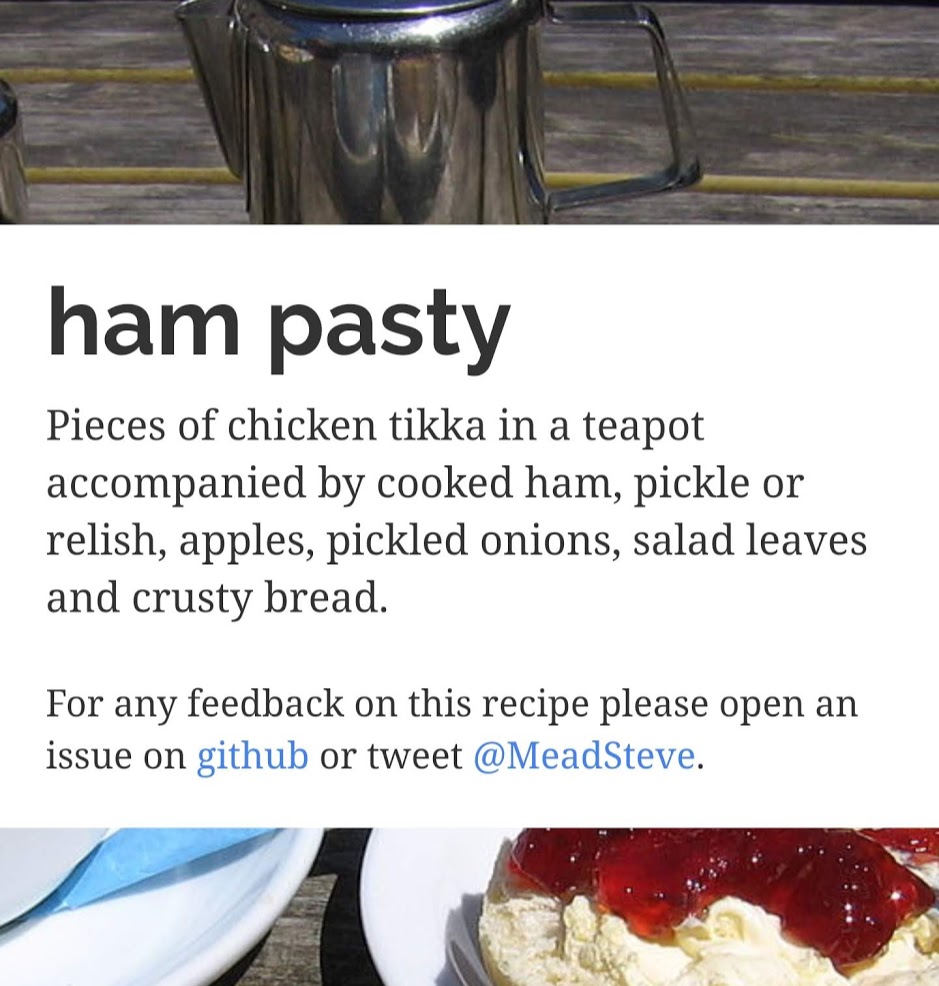How the British Food Generator works
Around a year ago a conversation at work made me realise that traditional british food names are a little bit strange. This lead me to create the British food generator. In this post I want to introduce a few of the pieces of code that power the British Food generator.
Names
The name generation is fairly simplistic. I took a bunch of traditional food names and split them into pieces. These pieces are then recombined randomly.

The complete code for doing this can be seen in the name generation module.
Description
Next I used a markov chain built on top of descriptions of British food. Markov chains are often used for pun/joke text generation as they can be quite good at generating almost realistic sentences.
I opted to use the markovify library as it was simple to use. The first step is to build a model from a sample of text. I collected descriptions of traditional british foods and put these in a text file. Markovify can then compile a model from this text. I wanted the description to reference the name in some way so a set of sample sentences are generated and are all scored based on whether they mention words in the food’s name.
def __init__(self, file_path):
# The init method reds in a text file and builds the markov chain
with open(file_path) as f:
text = f.read()
self._text_model = markovify.Text(text).compile()
def generate_food_description(self, name: str):
sample = (self._desc_at_total_random() for _ in range(0, 500))
scored_samples = (
(desc, self._score_description(desc, name)) for desc in sample
)
sorted_samples = sorted(scored_samples, key=lambda x: x[1])
best_fit = sorted_samples[0]
log.info(f"Returning a description with a score of {best_fit[1]}")
return best_fit[0]
def _desc_at_total_random(self):
return self._text_model.make_short_sentence(200, tries=100)
Full code for the description generation can be found in the description generation module.
Image
If possible I wanted to match the background image to the food being described. I did this by taking a selection of food images (from wikipedia) and filtering these to images that contain a word from the name or description. Full code for this can be found in the image generation module.
Bringing it all together
At this point I used my favourite framework for writing small APIs (FastAPI) combined with lagom for Dependency injection and wrote the following route:
# Setup fastapi with some html templates
app = FastAPI(title="British Food Generator")
templates = Jinja2Templates(directory="templates")
# Use lagom to configure my dependencies
# note: the markov chain is built here when the app starts
container = FastApiContainer()
container[FoodDescriber] = FoodDescriber(
os.path.join(__location__, "real_descriptions_of_food.txt")
)
container[CompleteDishBuilder] = Singleton(CompleteDishBuilder)
# Define how to respond to GET / requests
@app.get("/")
def read_root(request: Request, builder=container.depends(CompleteDishBuilder)):
dish = builder.generate_dish()
return templates.TemplateResponse(
"british_food.html",
{
"name": dish.name,
"description": dish.description,
"background_image": dish.image,
"request": request,
},
)
I’ve missed a few details out about how the CompleteDishBuilder works but all
this does is pull together all the pieces previously discussed.
This app is then deployed on heroku and we all get to enjoy:
